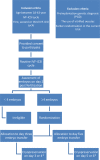Comparing the cumulative live birth rate of cleavage-stage versus blastocyst-stage embryo transfers between IVF cycles: a study protocol for a multicentre randomised controlled superiority trial (the ToF trial)
- PMID: 33441363
- PMCID: PMC7812106
- DOI: 10.1136/bmjopen-2020-042395
Comparing the cumulative live birth rate of cleavage-stage versus blastocyst-stage embryo transfers between IVF cycles: a study protocol for a multicentre randomised controlled superiority trial (the ToF trial)
Abstract
Introduction: In vitro fertilisation (IVF) has evolved as an intervention of choice to help couples with infertility to conceive. In the last decade, a strategy change in the day of embryo transfer has been developed. Many IVF centres choose nowadays to transfer at later stages of embryo development, for example, transferring embryos at blastocyst stage instead of cleavage stage. However, it still is not known which embryo transfer policy in IVF is more efficient in terms of cumulative live birth rate (cLBR), following a fresh and the subsequent frozen-thawed transfers after one oocyte retrieval. Furthermore, studies reporting on obstetric and neonatal outcomes from both transfer policies are limited.
Methods and analysis: We have set up a multicentre randomised superiority trial in the Netherlands, named the Three or Fivetrial. We plan to include 1200 women with an indication for IVF with at least four embryos available on day 2 after the oocyte retrieval. Women are randomly allocated to either (1) control group: embryo transfer on day 3 and cryopreservation of supernumerary good-quality embryos on day 3 or 4, or (2) intervention group: embryo transfer on day 5 and cryopreservation of supernumerary good-quality embryos on day 5 or 6. The primary outcome is the cLBR per oocyte retrieval. Secondary outcomes include LBR following fresh transfer, multiple pregnancy rate and time until pregnancy leading a live birth. We will also assess the obstetric and neonatal outcomes, costs and patients' treatment burden.
Ethics and dissemination: The study protocol has been approved by the Central Committee on Research involving Human Subjects in the Netherlands in June 2018 (CCMO NL 64060.000.18). The results of this trial will be submitted for publication in international peer-reviewed and in open access journals.
Trial registration number: Netherlands Trial Register (NL 6857).
Keywords: protocols & guidelines; reproductive medicine; subfertility.
© Author(s) (or their employer(s)) 2021. Re-use permitted under CC BY-NC. No commercial re-use. See rights and permissions. Published by BMJ.
Conflict of interest statement
Competing interests: None declared.
References
-
- Rienzi L, Gracia C, Maggiulli R, et al. . Oocyte, embryo and blastocyst cryopreservation in art: systematic review and meta-analysis comparing slow-freezing versus vitrification to produce evidence for the development of global guidance. Hum Reprod Update 2017;23:139–55. 10.1093/humupd/dmw038 - DOI - PMC - PubMed
Publication types
MeSH terms
LinkOut - more resources
Full Text Sources
Other Literature Sources

